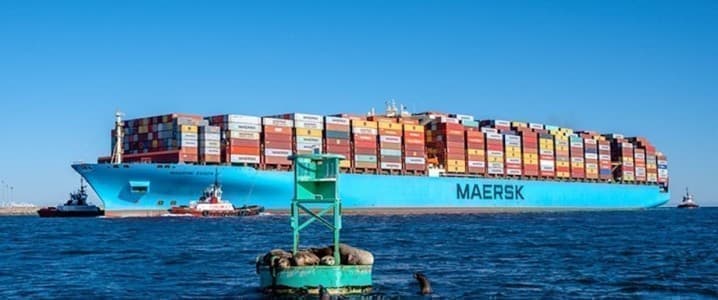Despite the longstanding reputation of the U.S. maritime industry, with its powerful navy and coast guard, as well as its well-established shipping routes, the U.S. imports a vast number of products, rather than using its maritime might for export purposes. Its strong commercial shipping and shipbuilding are failed by its weak supply chains, which are not as robust as those of China, from where many of the country’s essential goods are shipped. In 2022, China had approximately 1,200 large commercial ships under construction, significantly more than its U.S. counterpart. China owned over 7,300 commercial ships, around four times more than the U.S. The immaturity of U.S. supply chains became evident during the pandemic when America suddenly found itself lacking a multitude of products needed to support its various industries and consumer needs. Supermarket shelves quickly fell empty, as people found themselves at the beginning of the pandemic without essentials like toilet paper and pasta.
There were two main contributors to the shaping of current global supply chains. Firstly, China became the world’s dominant manufacturing hub, providing a large proportion of the world’s consumables and industrial parts. Secondly, it became clear that it was cheaper and faster to make products in China, deterring the U.S. (and the rest of the world) from establishing alternative supply chains. But, when the pandemic hit and everything came to a standstill, the supply chain weaknesses became apparent to everyone. Related: Energy, Metals Investments To Boom In 2023
Ever since the pandemic, consumers have battled with fewer products being readily available, as well as soaring prices, even for basic goods. Meanwhile, companies across a multitude of industries have had to delay output due to a lack of parts, particularly seen in the auto industry. So, what is the U.S. doing to ensure its supply chains are made more resilient?
Experts suggest that the U.S. must move the production of products such as pharmaceuticals, batteries, and computer chips either onshore or to countries near the U.S. to ensure easy access during times of crisis. Pressure from the pandemic has led several private companies to announce new domestic production plants, including tech firms, such as Intel. But many worry that the creation of a U.S. manufacturing hub will drive up prices, due to higher wages and other increased costs.
Despite the threat of higher costs, President Biden announced in 2021 in an executive order that resilient, diverse, and secure supply chains are necessary to ensure economic prosperity and national security. And several initiatives to boost national manufacturing and strengthen U.S. supply chains have followed. The government established a Supply Chain Disruptions Task Force to monitor and address short-term supply issues, meet with industry stakeholders, and identify supply chain disruptions to offer solutions.
In the longer term, the government plans to shift its supply chain strategy away from valuing low costs to focusing on security, sustainability, and resilience. The Biden Administration is recommending greater federal funding for the manufacturing of core parts, such as semiconductors. The U.S. also plans to develop supply chain relationships with its allies, to support one another in developing more resilient trade routes. And near the end of 2022, the Biden Administration announced almost $74 million in funding to advance domestic battery recycling and reuse to strengthen the supply chain.
Despite these advances, the U.S. is still lagging far behind China in terms of its supply chains. Special Presidential Coordinator Amos Hochstein stated this month, “Look, this is a major concern for the U.S. and I think for the rest of the world. As we are going into a cleaner, greener, an entirely new energy system, we have to make sure we have a diversified supply chain.” He added, “We can’t have a supply chain that is concentrated in any country, doesn’t matter which country that is… We have to make sure from the mining and refining process to the building of the batteries and wind turbines that we have a diversified system that we can be well supplied for. That is the only way this will work from an economy perspective.”
However, Hochstein suggested that although the U.S. has fallen behind, due to its complacency, it is not necessarily out of the game. The U.S. took a long time to realise the potential threat of China being in charge of much of its energy, industry, and consumer goods – with the pandemic and the Russian invasion of Ukraine being the catalysts for the supply chain discussion. But now the government is ready to invest in more resilient supply chains and encourage private companies to do the same.
We have already seen some progress in the form of Biden’s 2022 Inflation Reduction Act, which offers $369 billion in funding and tax credits to boost renewable energy technology and critical mineral production. This is expected to help strengthen supply chains related to the green transition. But greater financial and business incentives must be offered to boost the resilience of other supply chains. While the U.S. is still under China’s thumb, the first step to building reliant supply chains is the acknowledgement of this fact, followed by greater action to build stronger domestic and regional manufacturing operations and trade routes.
By Felicity Bradstock for Oilprice.com
More Top Reads From Oilprice.com:
- Republicans Seek To Scrap New Emissions Rule For Heavy-Duty Trucks
- Central Bank Buying Spree Lifts Gold Prices
- Bulgaria Remains Russia’s Number One European Oil Buyer



















The tariff war with China is a complete failure as it failed to cut China imports. In fact, China imports have increased significantly in all past years.
America was the main player in creating in a global supply chain. Any attempt to change it will not end well.